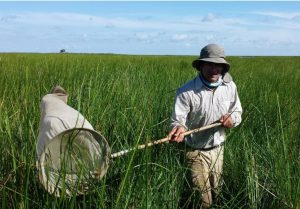Study Finds Hurricane Isaac Prolonged Oil Spill Impacts on Some Marsh Insects and Spiders
– AUGUST 30, 2018
Researchers collected and analyzed terrestrial arthropods from Louisiana marshes to determine the combined effects from Deepwater Horizon and Hurricane Isaac on saltmarsh ecosystems. The initial oiling from the spill (2010) followed by the oil’s redistribution during Hurricane Isaac (2012) negatively affected some arthropod groups three-four years after the spill. The degree of impact varied by taxa, with some arthropod groups not showing effects from the re-oiling. Overall abundance and taxonomic diversity of terrestrial arthropods increased from 2013 to 2014 at all sites, suggesting recovery. However, taxonomic richness was higher at reference sites for both years than at oiled sites, indicating possible long-term impacts from these disturbances. The researchers published their findings in PLoS ONE: Coupled effects of oil spill and hurricane on saltmarsh terrestrial arthropods.
Most people typically associate bites and stings with insects and spiders, but arthropods play an important role in marsh ecosystems. Arthropods are a food source for birds and estuarine fishes and they decompose organic material and influence nutrient dynamics in soil. Coastal Louisiana saltmarshes experience multiple chronic stressors from pollution (from crude oil released via seeps, leaks, spills and from agricultural and industrial development); reduced riverine nourishment (from increased levees and hydrologic alterations); and storm surges from tropical weather.
Study author Wokil Bam explained that terrestrial arthropods represent an important link to saltmarsh ecosystem dynamics. “Due to short-term life cycle and generation times, most arthropods can be considered ideal indicators for both short-term and long-term ecosystem monitoring. The large population size, high reproductive rates, short life cycle, and relatively easy sampling methods associated with arthropods help provide a statistically significant sample size with fewer chances of diminishing the population.”
Hurricane Isaac passed through coastal areas that were oiled during Deepwater Horizon. To understand the effects from these disturbances, this study’s researchers collected arthropods in 2013 and 2014 using sweep nets (from the marsh edge to 20 m inland) in Delacroix (reference site, no oiling) and Barataria Bay (light-to-heavy oiling from spill and re-oiling following Hurricane Isaac). Using taxonomic keys and the morphospecies approach, the team’s efforts yielded 21,732 specimens across 28 families. Then they compared the effects of oiling levels by year with arthropod abundance, and they calculated taxonomic richness and diversity and community structure for oiling levels and years.
There were fewer planthoppers at reference sites in 2013, but their abundance returned in 2014 suggesting recovery. There were fewer flies at reference sites for both years, but their stable numbers at oiled sites may be due to increased dead and decaying material that draws flies. There were fewer spiders at reference sites in 2013, but their abundance increased in 2014 possibly related to a recovery of their prey populations.
There were more dragonflies and damselflies at reference sites for both years. There were more herbivorous katydids and thrips at oiled sites, consistent with herbivore blooms associated with environmental disturbances and decreased predators. There were more crickets at all sites in 2014, possibly as a result of contaminated soil recovery, and more ants at all sites in 2014, possibly because of their spring mating season.
The populations of midges and mosquitoes remained the same across all sites and years.
Taxonomic diversity increased in 2014 compared to 2013, suggesting whole-ecosystem recovery from Hurricane Isaac within 6 – 18 months or a multiyear recovery after Deepwater Horizon. However, taxonomic richness was higher in reference sites in both years than in oiled sites, suggesting that reference sites may be healthier compared to the oiled sites and that, even after four years, taxonomic richness may still be negatively affected by persistent oil residues.
Bam explained more about their findings, “We found that terrestrial arthropod communities are capable of recovery from ecological or chemical disturbance, though the rate of recovery for specific arthropods might be different. Some of the arthropod groups were affected in years three (2013) and four (2014) after the disaster, whereas some didn’t show any response at this time, suggesting that a select group of arthropods can serve as indicator of the stress due to the distribution and re-distribution of oil in the marsh. Overall, the ecosystem appears to be oscillating around intermediate disturbance due to the hurricane and the redistribution of oil.”
Data are publicly available through the Gulf of Mexico Research Initiative Information & Data Cooperative (GRIIDC) at doi:10.7266/N7K935FT.
The study’s authors are Wokil Bam, Linda M. Hooper-Bui, Rachel M. Strecker, Puspa L. Adhikari, and Edward B. Overton.
************
This research was made possible in part by a grant from the Gulf of Mexico Research Initiative (GoMRI) to the Coastal Waters Consortium II (CWC II) consortium.
The Gulf of Mexico Research Initiative (GoMRI) is a 10-year independent research program established to study the effect, and the potential associated impact, of hydrocarbon releases on the environment and public health, as well as to develop improved spill mitigation, oil detection, characterization and remediation technologies. An independent and academic 20-member Research Board makes the funding and research direction decisions to ensure the intellectual quality, effectiveness and academic independence of the GoMRI research. All research data, findings and publications will be made publicly available. The program was established through a $500 million financial commitment from BP. For more information, visit https://gulfresearchinitiative.org/.
© Copyright 2010-2018 Gulf of Mexico Research Initiative (GoMRI) – All Rights Reserved. Redistribution is encouraged with acknowledgement to the Gulf of Mexico Research Initiative (GoMRI). Please credit images and/or videos as done in each article. Questions? Contact web-content editor Nilde “Maggie” Dannreuther, Northern Gulf Institute, Mississippi State University (maggied@ngi.msstate.edu).






